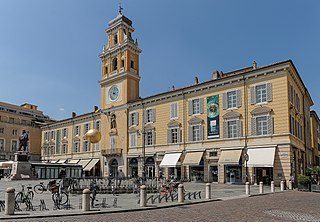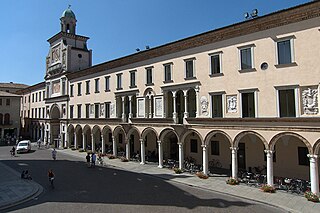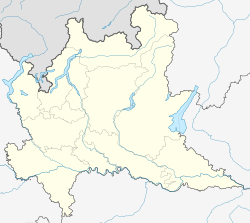
Parma is a city in the northern Italian region of Emilia-Romagna famous for its architecture, music, art, prosciutto (ham), cheese and surrounding countryside. It is home to the University of Parma, one of the oldest universities in the world. Parma is divided into two parts by the stream of the same name. The district on the far side of the river is Oltretorrente. Parma's Etruscan name was adapted by Romans to describe the round shield called Parma.

Cremona is a city and comune in northern Italy, situated in Lombardy, on the left bank of the Po River in the middle of the Pianura Padana. It is the capital of the province of Cremona and the seat of the local city and province governments. The city of Cremona is especially noted for its musical history and traditions, including some of the earliest and most renowned luthiers, such as Giuseppe Guarneri, Antonio Stradivari, Francesco Rugeri, Vincenzo Rugeri, and several members of the Amati family.

The Province of Brescia is a Province in Lombardy, northern Italy. It has a population of some 1,265,325 and its capital is the city of Brescia.

Bagnolo Mella is a comune and town in the province of Brescia, in Lombardy.

Borgosatollo is a comune in the province of Brescia, in Lombardy. It is bounded by other communes of Brescia, Castenedolo, Montirone, Poncarale and San Zeno Naviglio, and situated directly south of Brescia, in the plain.
Borgosatollo's area include also two frazioni, Gerole and Piffione.

Castenedolo is a comune in the province of Brescia, in Lombardy. It is bounded by other communes of Montichiari and San Zeno Naviglio. The commune is situated in the plain southeast of Brescia.

Iseo is a town and comune in the province of Brescia, in Lombardy, Italy, on the south shore of Lake Iseo. It is bounded by the communes of Provaglio d'Iseo, Sulzano, Polaveno and Paratico.

Manerbio is a town and comune in the province of Brescia, in Lombardy, northern Italy. It received the honorary title of city with a presidential decree on May 14, 1997.

Serle is a comune in the province of Brescia, in Lombardy, Italy. It is bordered by the neighboring communes of Nuvolento, Caino and Botticino.

Peschiera del Garda is a town and comune in the province of Verona, in Veneto, Italy. When Lombardy-Venetia was under Austrian rule, Peschiera was the northwest anchor of the four fortified towns constituting the Quadrilatero. The fortress is on an island in the river Mincio at its outlet from Lake Garda.

Crema is a city and comune in the province of Cremona, in the region of Lombardy in northern Italy. It is built along the river Serio at 43 kilometres (27 mi) from Cremona. It is also the seat of the Catholic Bishop of Crema, who gave the title of city to Crema.

Goito is a comune of Lombardy, northern Italy, part of the Province of Mantua, from which it is some 20 kilometres (12 mi), on the road to Brescia. It is on the right bank of the Mincio River near the bridge. The town is part of the region known as Alto Mantovano (Upper Mantuan).

Cernusco sul Naviglio is a town and comune in the Metropolitan City of Milan, Lombardy, northwestern Italy. With a population of 33,436 as of 2015 it is the 14th-largest municipality in the metropolitan city.

Rosà is a town of 14.328 inhabitants in the province of Vicenza, Veneto, Italy. The name comes from the Latin word "roxata", the ancient name of the biggest irrigation channel that passed in that area. The municipality has got 4 hamlets. Rosà is officially European Town of Sport 2011.

Castano Primo is a city and comune in Province of Milan, in the Italian region Lombardy, located about 35 kilometres northwest of Milan.

Trezzano sul Naviglio is a comune (municipality) in the Metropolitan City of Milan in the Italian region Lombardy, located about 9 km (6 mi) southwest of Milan.

Cenate Sotto is a comune (municipality) in the Province of Bergamo in the Italian region of Lombardy, located about 60 kilometres (37 mi) northeast of Milan and about 12 kilometres (7 mi) east of Bergamo. As of 31 December 2004, it had a population of 2,947 and an area of 4.5 square kilometres (1.7 sq mi).

Castelvetro Piacentino, also known as Castelvetro, is a town and comune (municipality) in the Province of Piacenza in the Italian region Emilia-Romagna, located about 130 kilometres (81 mi) northwest of Bologna and about 25 kilometres (16 mi) east of Piacenza.

Villanova sull'Arda is a comune (municipality) in the Province of Piacenza in the Italian region Emilia-Romagna, located about 120 kilometres (75 mi) northwest of Bologna and about 25 kilometres (16 mi) east of Piacenza.

Brescia railway station is the main station of Brescia, in the region of Lombardy, northern Italy. The station, opened in 1854, lies on the Milan-Venice railway and is a terminus of three branch lines: Valcamonica Railway to Edolo, Brescia-Lecco railway and Brescia-Piadena/Cremona railway which branches off towards southeast of the station.

















